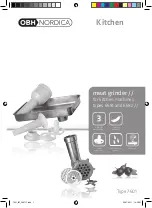
Thank you for purchasing the Drawsharp, invented by chairmaker Peter Galbert, designed with and built by
Benchcrafted. The Drawsharp makes drawknife sharpening a quick, easy and repeatable process, yielding
beautifully polished edges otherwise difficult to achieve with other methods. Everything you need is in the tin,
including enough abrasives for dozens of sharpening sessions. Refill kits are available at Benchcrafted.com.
Assembly Instructions
Insert the cap screws through the body and slip
the wear plate over the screws, threading the two
bumpers onto the screws. Tighten the cap screws
with an allen wrench. When the wear plate wears
with use, flip it over and use the other side.
Remove the backing paper from the VELCRO
bearing and adhere the VELCRO into the recess in
each post. Use an allen wrench to thread a stud
into each post until the yellow locking element
engages fully.
Do this with the
post inserted in
the body’s slot
for resistance. Insert each post into the slot in the body and thread a nut onto each stud from below. The flat portion of
the post’s collar should face the bumpers. Apply one abrasive paper pad to each sleeve opposite each diamond pad. Each
sleeve should have one of each abrasive on it: a diamond pad on one side of the sleeve, and the abrasive paper pad on the
opposite side of the same sleeve. One sleeve will be used to sharpen the drawknife’s bevel, the other it’s back. So each
sleeve needs to have both types of abrasive on it.
Prepping Your Knife
Before using the Drawsharp you’ll need to check the back edge (the “spine”) of the drawknife to make sure its smooth
enough to work with the Drawsharp. If the spine needs attention, use a file and some fine sandpaper to smooth and polish
and round the edges of the spine so it slides smoothly in the Drawsharp. Evaluate the present condition of the edge of the
tool. Most knives that have been sharpened with other methods will be ready to hone with the Drawsharp. If you are
“rehabbing” a knife with a misshapen or knicked edge, refer to videos on our website for instruction on grinding. The best
cutting geometry will begin with a knife that has a bevel ground to approximately 27 degrees. If your knife is ground with a
bevel beyond 30 degrees, you might consider grinding it before honing, to lower the angle.
Setting the Drawsharp
The Drawsharp works on the same principle as typical honing guides: presenting the tool’s edge to the
abrasive in a controlled, repeatable fashion. The distance from the bumpers to the posts (and thus the
sleeves and abrasive) determines the sharpening angle. Here’s how to set the posts. Place the drawknife
in a vise so the blade is vertical as shown (handles not shown for clarity). The cutting edge should be facing
away from the Drawsharp body. You’ll note that the bumpers are not in the exact middle of the body. The
shorter side of the body will be set for the back of the blade and the long side for the bevel. This is marked
“back” and “bevel” on the body. Place the Drawsharp onto the spine of the drawknife until the blunt edge is
resting on the wear plate and against one side of the bumpers as
shown. It doesn’t matter which side (bevel or back) you start with,
just make sure you place the knife on the correct side for setting the
back post and bevel post. Loosen the nut and with the spine of the knife in contact with the wear plate and
bumpers, slide the post until the bevel (or back) is flat against the diamond abrasive pad on the sleeve. Tighten
the nut. Now place the Drawsharp so the knife is on the other side of the bumpers to set the other post. With
the posts in this position, the entire bevel and back would be presented to the abrasive. What you want is a
slight micro bevel so you’re polishing only the very cutting edge. To position the posts to create this micro
bevel, note the position of the posts’ indicator mark on the scale, then move each post AWAY from the bumpers ONE mark only. The numbers on the
scales and the distances between the marks are purely arbitrary. They don’t represent sharpening angles or distances. They are simply a means for
identifying post settings for a particular drawknife. This makes setting the Drawsharp for different drawknives quick, once the initial setting is
determined. The gap in numbers between the scales is intentional. It helps prevent possible confusion between the two settings. If you’re curious about
sharpening angles, you can measure the angle of the micro bevels by setting the Drawsharp on the bench top with the posts pointing up, and the
drawknife placed in the Drawsharp as when setting the post position.To measure the micro bevel angle of the back of the drawknife, use a bevel square.
Place the square’s blade right on the back of the knife with the stock laying on the benchtop. The difference between that angle and 90 degrees is the
Component List:
Body
Wear Plate
Nut (2)
Cap screw (2)
Bumper (2)
Post (2)
Stud (2)
Sleeve (2)
VELCRO® loop
bearing (2)
Diamond pad (2)
PSA abrasive paper
pad (10)




















